
Alex Kozinski is a Romanian-American jurist and lawyer who was a judge on the U.S. Court of Appeals for the Ninth Circuit from 1985 to 2017. He was a prominent and influential judge, and many of his law clerks went on to clerk for U.S. Supreme Court justices.
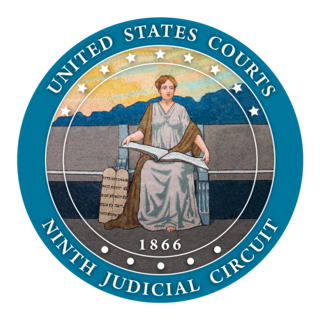
The United States Court of Appeals for the Ninth Circuit is the U.S. federal court of appeals that has appellate jurisdiction over the U.S. district courts in the following federal judicial districts:

The Supreme Court of California is the highest and final court of appeals in the courts of the U.S. state of California. It is headquartered in San Francisco at the Earl Warren Building, but it regularly holds sessions in Los Angeles and Sacramento. Its decisions are binding on all other California state courts. Since 1850, the court has issued many influential decisions in a variety of areas including torts, property, civil and constitutional rights, and criminal law.

The California Courts of Appeal are the state intermediate appellate courts in the U.S. state of California. The state is geographically divided along county lines into six appellate districts. The Courts of Appeal form the largest state-level intermediate appellate court system in the United States, with 106 justices.

Plumas National Forest is a 1,146,000-acre (4,640 km2) United States National Forest located at the northern terminus of the Sierra Nevada, in northern California. The Forest was named after its primary watershed, the Rio de las Plumas, or Feather River.
Vroegh v. Eastman Kodak Company, et al. is a class action complaint that alleges that the defendants, "[i]n marketing, advertising and/or packaging their Flash Memory Cards and Flash Memory Drives, Defendants misrepresent the size of the memory storage contained in the Flash Memory Cards and Flash Memory Drives." The complaint accuses the defendants of "false advertising, unfair business practices, breach of contract, fraud, deceit and/or misrepresentation, and violation of the California Consumers Legal Remedy Act".

Superior courts in California are the state trial courts with general jurisdiction to hear and decide any civil or criminal action which is not specially designated to be heard in some other court or before a governmental agency. As mandated by the California Constitution, there is a superior court in each of the 58 counties in California. The superior courts also have appellate divisions which hear appeals from decisions in cases previously heard by inferior courts.
David Ormon Carter is a United States district judge of the United States District Court for the Central District of California.
Ronald Richards is a Beverly Hills, California based criminal defense and civil litigation attorney who has made national media appearances as a legal expert commentator. He was the first lawyer to be cited on California Proposition 215 (1996), the medical marijuana statute, and worked as a professor of law at the San Fernando Valley College of Law from 2006 to 2007. Since 2011 Richards has sat as a temporary judge on the Los Angeles Superior Court.

The Rough Fire was a major wildfire in Fresno County, California, and the largest of the 2015 California wildfire season. The fire was ignited by a lightning strike on July 31 and burned 151,623 acres (61,360 ha), largely in the Sierra National Forest and the Sequoia National Forest, before it was declared contained on November 6, 2015. At the time it occurred, the fire was the thirteenth largest in recorded California history.

The Soberanes Fire was a large wildfire that burned from July to October 2016 in the Santa Lucia Mountains of Monterey County, California. It destroyed 57 homes and killed a bulldozer operator, and cost about $260 million to suppress, making it at the time the most expensive wildfire to fight in United States history. At the fire's peak, over 5,000 personnel were assigned to the blaze. The fire was the result of an illegal campfire in Garrapata State Park. By the time it was finally extinguished, the fire had burned 132,127 acres (53,470 ha) along the Big Sur coast in the Los Padres National Forest, Ventana Wilderness, and adjacent private and public land in Monterey County, ranking it 18th on the list of the largest California wildfires in terms of acreage burned.
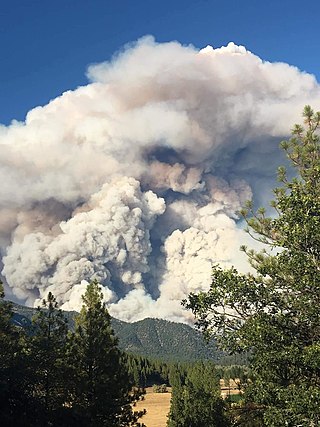
The Walker Fire was a wildfire that burned near Genesee Valley in the Plumas National Forest approximately 11 miles east of the community of Taylorsville in Plumas County, California. The blaze was reported on Wednesday, September 4, 2019 and immediately expanded in size over its several days of burning. The fire actively threatened homes from Genesee Valley to Antelope Road.

The 2020 Loyalton Fire was a large wildfire in Lassen, Plumas and Sierra counties in California and Washoe County in Nevada. After it was ignited by lightning on August 14, 2020, the fire burned 47,029 acres (19,032 ha) in the Tahoe National Forest and the Humboldt-Toiyabe National Forest before it was fully contained on August 26. The Loyalton Fire was notable for generating three fire tornadoes on August 15, necessitating first-of-their-kind warnings by the National Weather Service.

The 2020 Creek Fire was a very large wildfire in central California's Sierra National Forest, in Fresno and Madera counties. One of the most significant fires of California's record-setting 2020 wildfire season, it began on September 4, 2020, and burned 379,895 acres (153,738 ha) over several months until it was declared 100% contained on December 24, 2020. The Creek Fire is the fifth-largest wildfire in recorded California history and the second-largest single fire—i.e. not part of a larger wildfire complex—following the 2021 Dixie Fire.

The North Complex Fire was a massive wildfire complex that burned in the Plumas National Forest in Northern California in the counties of Plumas and Butte. 21 fires were started by lightning on August 17, 2020; by September 5, all the individual fires had been put out with the exception of the Claremont and Bear Fires, which merged on that date, and the Sheep Fire, which was then designated a separate incident. On September 8, strong winds caused the Bear/Claremont Fire to explode in size, rapidly spreading to the southwest. On September 8, 2020, the towns of Berry Creek and Feather Falls were immediately evacuated at 3:15 p.m. PDT with no prior warning, By September 9, 2020, the towns of Berry Creek and Feather Falls had been leveled, with few homes left standing. The fire threatened the city of Oroville, before its westward spread was stopped. The fire killed 16 people and injured more than 100. Among the 16 fatalities was a 16-year-old boy. The complex burned an estimated 318,935 acres (129,068 ha), and was 100% contained on December 3. The fire was managed by the U.S. Forest Service in conjunction with Cal Fire, with the primary incident base in Quincy. The North Complex Fire was the sixth-largest in California's modern history, and the deadliest fire in the 2020 California wildfire season.
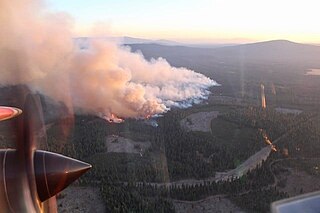
The 2020 Lassen County wildfire season included seven large wildfires that burned entirely or in part in Lassen County. A total of 203,296 acres (82,271 ha) of land was burned in Lassen County, making it one of the larger clusters of fires in the 2020 California wildfire season.
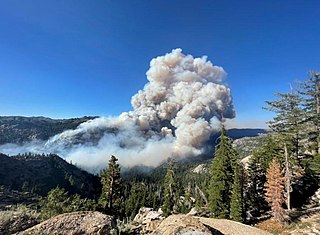
The Tamarack Fire was a wildfire that burned 68,637 acres (27,776 ha), primarily in the Mokelumne Wilderness in Alpine County, California, Douglas County, Nevada and Lyon County, Nevada, as part of the 2021 California wildfire season.
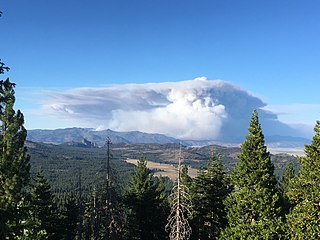
The Beckwourth Complex was a wildfire complex that burned in the Plumas National Forest in Plumas and Lassen counties. The two major fires of the complex, the Dotta Fire and the Sugar Fire, started on June 30 and July 2 northeast of Beckwourth, California. Started by lightning strikes, the two fires collectively burned 105,670 acres (42,763 ha). The complex resulted in the evacuation of numerous residential areas and the closure of portions of Plumas National Forest. In the community of Doyle, California, 33 homes were destroyed.

The Caldor Fire was a large wildfire that burned 221,835 acres in the Eldorado National Forest and other areas of the Sierra Nevada in El Dorado, Amador, and Alpine County, California, in the United States during the 2021 California wildfire season. The fire was first reported on Saturday, August 14, 2021, and was fully contained on Thursday, October 21, 2021. The Caldor Fire destroyed 1,005 structures and damaged 81 more, primarily in the US Highway 50 corridor and in the community of Grizzly Flats, 2/3 of which was destroyed by the fire.

The Storrie Fire was a sizeable wildfire in Northern California's Plumas County and the second-largest of California's 2000 wildfire season. The fire began on August 17, 2000, and was fully contained by September 9; it burned 55,261 acres in total and resulted in minimal property damage or casualties. The cost of containing the Storrie Fire amounted to $22 million.



















